
72 minute read
News



News Professional Builder
SUICIDE RATE INCREASES
ONS statistics show construction suicide rate increase
The ONS has just released the latest suicide statistics for England and Wales and the Lighthouse Construction Industry Charity has shared the data. The number of suicides attributed to construction occupations in 2021 was 507, most of which are male (503).
This figure constitutes a rise of 24 from the previous year and 25 more than the previous five year average and equates to 34 per 100,000 in employment and means workers in construction were nearly four times more likely to take their own lives compared to other sectors in 2021.
© Tap10/Adobe Stock
Dear PB,
Thank you for addressing the issue of mental health and suicide rates within society in general, and especially within the building trade. I had no idea of the statistics regarding the trade sector. Thank you for highlighting this and for publishing it in your magazine. I picked up a copy yesterday, it was the first time I’d even heard of you. I read it. It resonated. Thank you for this. Keep doing what you’re doing, and let’s all keep talking about this. It literally does save lives to talk. Gareth x
FOR MORE INFORMATION ON THE HELP AND SUPPORT AVAILABLE VISIT: WWW.RDR.LINK/BAP001
LIFTING THE LID
Early findings from HSE’s latest health campaign on moving and handling revealed
The Health and Safety Executive carried out more than 1,000 inspections late last year checking how workers were moving heavy, bulky and awkward-tohandle materials. Many examples of good practice were found, including the widespread use of mechanical equipment. However, HSE personnel also found many examples of poor practice, including a worker lifting an 80kg kerb on his own without any assistance from machinery, lifting aids or colleagues, and a 110kg floor saw that had to be moved into and out of a work van by two operatives at a street works site, both of which resulted in enforcement action.
FOR MORE DETAILS VISIT: WWW.RDR.LINK/BAP002
ARMD GUARD
ARMD and Van Guard team up to prevent and protect tradespeople against van crime
ARMD and Van Guard have announced a new partnership designed to help protect tradespeople against tool theft and van crime. The partnership brings together Van Guard’s range of tough van security products with ARMD’s smart insurance and fast digital claims.
FOR MORE INFORMATION ON ARMD VISIT: WWW.RDR.LINK/BAP003 FOR MORE INFORMATION ON VAN GUARD VISIT: WWW.RDR.LINK/BAP004
SETTING THE STANDARD
The latest edition of NHBC’s Technical Standards are now live.
There are significant changes and updates to several chapters, including aligning with British Standards BS EN 1992, BS 8666 and BS 8102:2022. Updates to both concrete upper floor design and timber/joist deflection limits and to the weathertightness of windows, doors and glazing. New guidance on the provision of horizontal movement joints on masonry clad buildings and on supporting single leaf garage walls as well as addressing the low carbon agenda.
FOR MORE INFORMATION VISIT: WWW.RDR.LINK/BAP005




News Professional Builder email your news to us at pb@hamerville.co.uk Tel 01923 237799
NET GAINS
UK heating industry tells Business Secretary it’s “time to get serious” with net zero homes

EFFICIENCY DRIVE
Joint call for energy efficiency drive to tackle cost of living crisis
Improving the energy efficiency of the UK’s buildings will permanently bring down energy bills for households and boost energy independence, according to four leading associations. Energy UK, the Local Government Association, the Federation of Master Builders and the National Housing Federation are calling on the Government to continue to prioritise energy efficiency as a core solution to the costof-living crisis. Insulating British housing is a long-term challenge, but it will help keep households bills down permanently, all while supporting the transition to Net Zero through reducing emissions.
FOR MORE INFORMATION VISIT: WWW.RDR.LINK/BAP006
HOT TOPIC
Government insulation plans a “welcome step in the right direction”, says HHIC
The ECO+ Scheme has been hailed a welcome step in the right direction in improving energy efficiency in UK homes by the Heating & Hotwater Industry Council (HHIC). The initiative will set aside £1bn to improve insulation among the UK’s homes. It will help to reduce energy costs households by around £310 a year and extend support to those in the least energy efficient homes in lower Council Tax bands.
HHIC HAS ALSO PRODUCED ITS OWN
GUIDE: IMPROVING THE EFFICIENCY OF HOME HEATING. TO READ THE GUIDE, VISIT WWW.RDR.LINK/BAP007
It’s “time to get serious on net zero homes” according to Energy and Utilities Alliance (EUA), Chief Executive, Mike Foster and explore all the options available in more detail. Currently the gas networks are examining the option of hydrogen villages, exploring how homes can be converted from mains gas to hydrogen. The EUA is calling for a similar village trial that would focus on heat pumps.
FOR MORE DETAILS VISIT: WWW.RDR.LINK/BAP008
SECURE IN THE KNOWLEDGE
The construction industry is among the most secure jobs in the UK
Reassured has revealed the 10 best industries for job security, looking at redundancy rates in the UK from 2011 to 2021 where construction saw 65% less job losses. Northern Ireland is the best area for job security with a redundancy total of just 7,579. Even though the Northeast experiences nearly double the number of redundancies (14,663) the region comes in second, closely followed by
Wales with 15,218 jobs made redundant.
TO FIND OUT MORE ABOUT THE RESEARCH VISIT: WWW.RDR.LINK/BAP009
MARK OF QUALITY
TrustMark partnership with hiber gives installers access to 24/7 back-office support
Installers registered with the Licence Plus scheme from TrustMark can now price installs, order equipment and appliances, as well as handle payments seamlessly through their smartphone or tablet thanks to a new partnership with back-office support app, hiber. The Licence Plus Scheme aims to showcase installers’ competency and quality workmanship while supporting efforts towards reducing energy use to save households money and reach the UK’s Net Zero goals.
FOR MORE DETAILS VISIT: WWW.RDR.LINK/BAP010
© Fascinadora/Adobe Stock PAYING THE PRICE

The Construction Leadership Council’s Product Availability working group provides an update on supply issue
Overall product availability is good and returning to pre-Covid levels, while some bricks, blocks, plasterboard and roofing products are occasionally still subject to disruption or allocation. Prices have slightly moderated across the board but, looking ahead, rising energy and wage costs are expected to exert significant upward pressure. This will be felt most keenly by manufacturers of energy-intensive products such as bricks, cement, glass, insulation and plasterboard.
FOR MORE DETAILS VISIT: WWW.RDR.LINK/BAP011
Apprentice Paperhanger of the Year winners (L-R): Jade Oakes (Junior winner), Rebecca Mackinnon (Senior winner), Harry Davies (Junior runner-up), Calib Dyson (Judges Achievement and Commendation Award), Cameron Bonthron (Senior runner-up)

WALL OF FAME
The winners of a gruelling six-hour wallpaper hanging challenge have been presented with their awards
The PDA’s annual Apprentice Paperhanger of the Year competition challenges Level One and Level Two apprentices to showcase their talent. Senior Winner of the Apprentice Paperhanger of the Year 2022 was Rebecca Mackinnon, an apprentice at Neil Mackay & Co Ltd, who attends UHI Inverness.
FOR MORE DETAILS VISIT: WWW.RDR.LINK/BAP012
EVERYONE’S A WINNER!
BMI UK & Ireland are proud to announce the IMA Awards 2022 recipients
The annual IMA Awards celebrate the very best in flat roofing. Tucker & Tunstalls Roofing, NRA Roofing & Flooring Services, Itech Roofworks, Mac Roofing and William Patel from SPR Roofing Contractors were amongst the winners.
Installer of the Year –William Patel
FOR MORE DETAILS VISIT: WWW.RDR.LINK/BAP013
BUILDER’S BUILDER’S Professional Professional We give our verdict on new products in our unique site tests, but now we want to give you the chance to try them – AND KEEP THEM – for yourself! All you have to do to enter the free draws is simply just type in www.rdr.link followed by the unique code. FREEFORALL!

10X 1L HARDWAX OIL
ARMOURFLEX HARD WAX OIL
Armourflex® Hardwax Oil for wooden floors is tough, durable and water repellent. The flowing liquid penetrates deeply into the wood allowing it to cure within the wood grain in a strong protective hold, enhancing the woods natural beauty and authenticity. Containing a blend of natural oils and waxes, it is suitable for protecting and enhancing the durability of all interior wood surfaces including hardwood, softwood, parquet and veneer. It is also resistant to common stains such as wine, coffee and soft drinks.
Make use of our digital reader enquiry service and use the rdr.link below to go straight to Professional Builder’s great competitions.
FOR YOUR CHANCE TO WIN VISIT: WWW.RDR.LINK/BAP016
2X SHOWERHEADS
HANSGROHE PULSIFY SELECT S SHOWERHEADS
With a sleek, compact design and Matt Black finish, Pulsify hand showers by hansgrohe are equipped with three different spray modes. The 105 3jet relaxation model includes a microfine PowderRain spray to envelope you in water droplets, Intense PowderRain for an invigorating shower and a relaxing massage spray.
We’re showering you with great giveaways once again including this hansgrohe product.
FOR YOUR CHANCE TO WIN VISIT: WWW.RDR.LINK/BAP017


1X JOB SITE RADIO

MAKITA MR003GZ DAB/DAB+ JOB SITE RADIO
Powered by AC adaptor or Makita’s 40VMax XGT, 18V LXT and 12VMax CXT batteries, the MR003GZ features an AUX-IN jack to turn the radio into a speaker for personal audio and a USB port for charging mobile devices. Capable of receiving AM/FM and DAB/DAB+ frequencies, the unit benefits from elastomer bumpers and an IP65-rated dust and shower-proof construction.
Sounds like yet another great prize from Professional Builder!
FOR YOUR CHANCE TO WIN VISIT: WWW.RDR.LINK/BAP018
1X FLOODLIGHT CAMERA
YALE MAINS POWERED FLOODLIGHT CAMERA
With smartphone control, the Yale Floodlight Camera allows homeowners to monitor the outside of their home easily and conveniently at any time of the day or night. The 1080 FHD video quality is complemented by multiple lighting modes that configure the brightness to a maximum of 2,000 lumen, and there’s no monthly subscription fees.
This bright idea in home security could be yours if you enter on the Professional Builder website.
FOR YOUR CHANCE TO WIN VISIT: WWW.RDR.LINK/BAP019
Easy to Enter! It’s now easier than ever before to enter the competitions on our website. We’ve collected all the competitions on one handy page, meaning you only have to enter your details once! www.rdr.link/BAP020
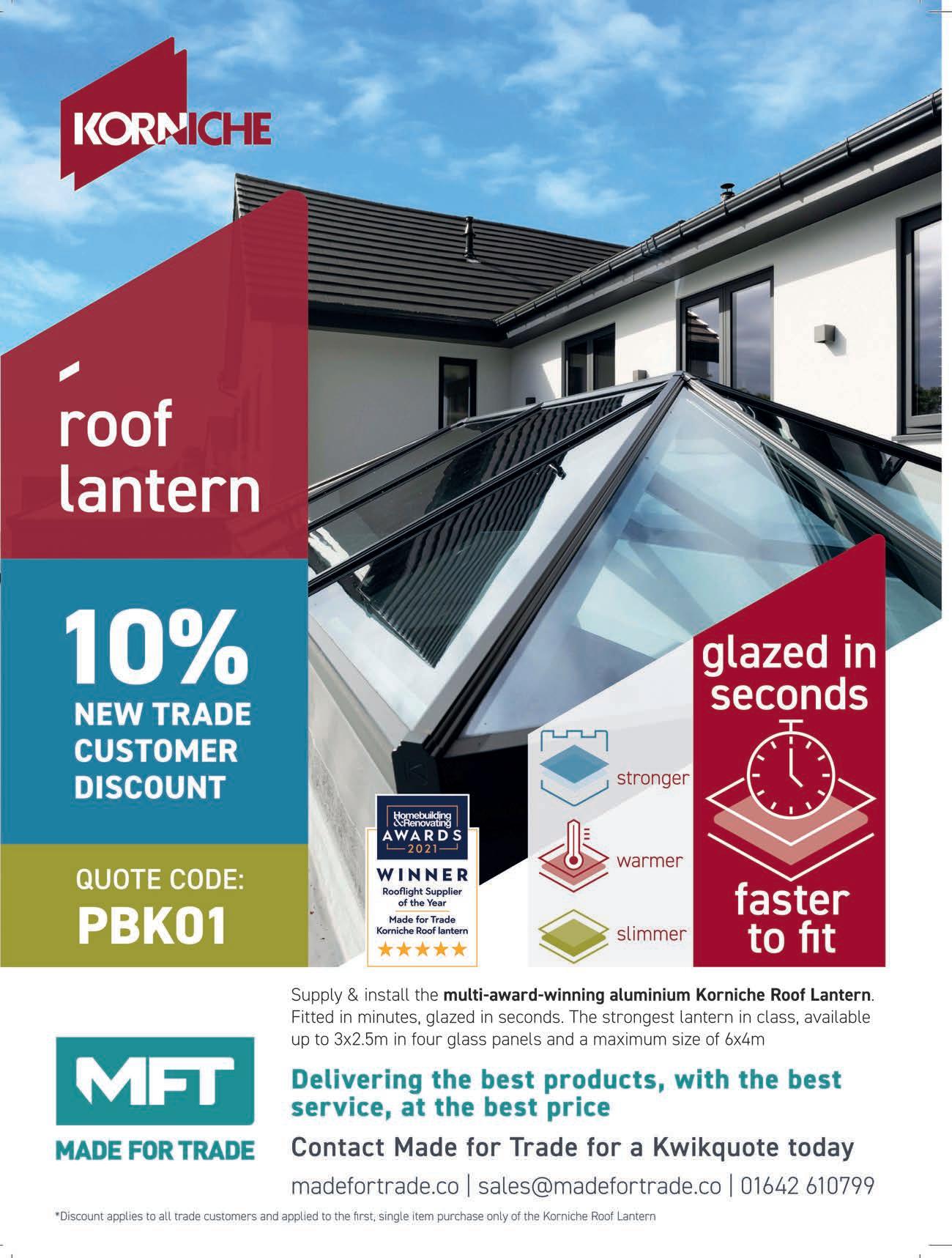

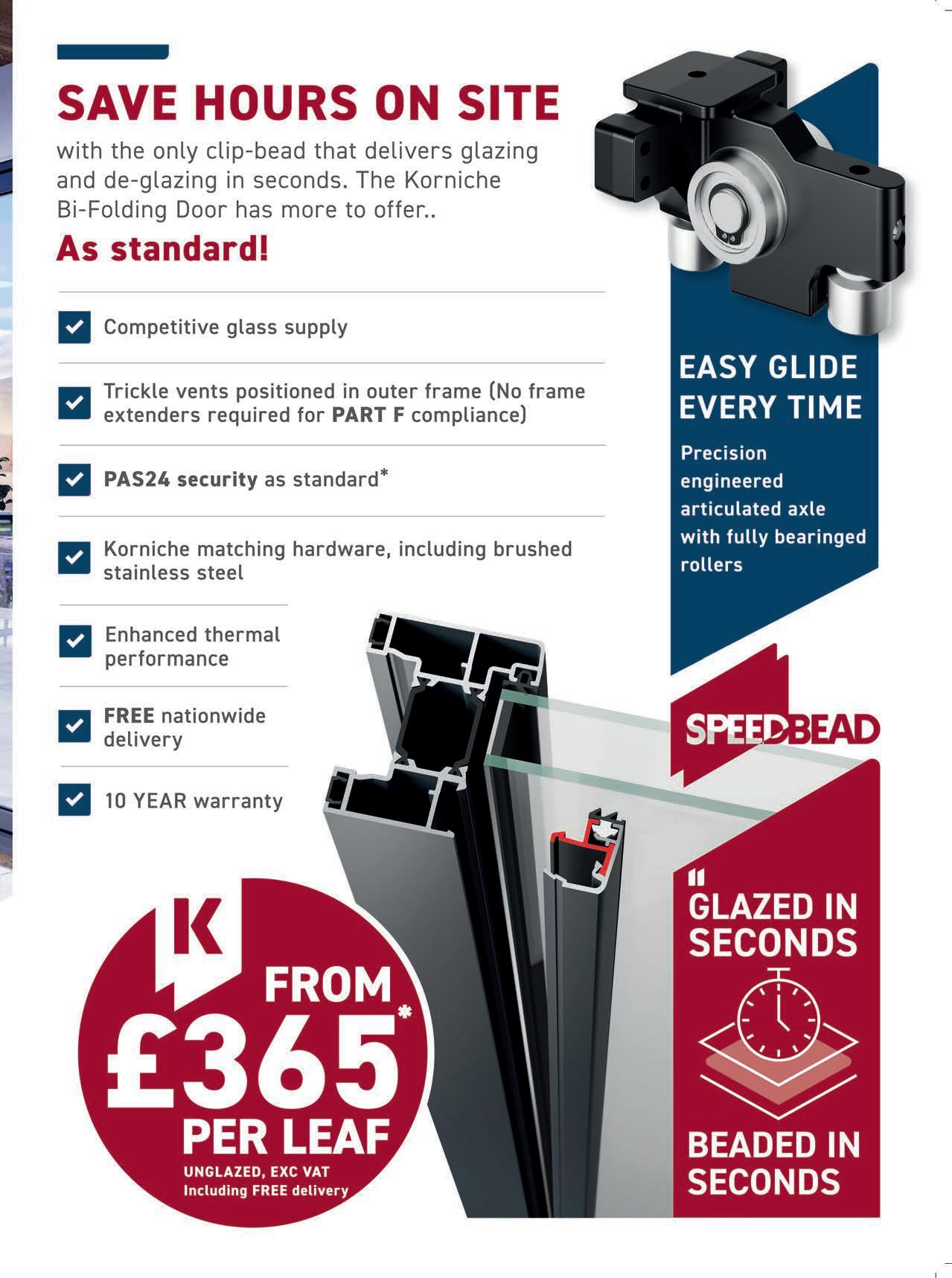



HOME TRUTHS
A new guide on becoming a smaller housebuilder is the brainchild of FMB Vice President, Chris Carr. Professional Builder’s Lee Jones talks to the managing director of Cleethorpes-based Carr & Carr about the advice the initiative hopes to communicate to contractors.

There is no doubt that a welldocumented decline in SME house builders is hampering our ability to provide much needed new homes. Forty years ago, in fact, small and medium sized firms delivered 40% of new registrations whilst today that figures stands at 10%.
Micro and SME developers tend to build on the basis of quality, rather than quantity, driving up standards, championing new ideas, and encouraging differentiation. Increasing the number of available homes overall will have a positive impact on the trades, as well as the building materials supply chain. It will allow companies to employ locally and train many more new recruits. Add to that the obvious benefit for house hunters currently stumbling to find a foothold on the property ladder, and the advantages to the wider economy and society at large are self-evident.
A new Construction Leadership Council (CLC) document – “Becoming a small housing developer: advice and guidance from others in the new homes industry” – is designed to help individuals and companies who might be embarking on their own new build journey to navigate the finance, land availability and planning issues that still deter far too many from taking the first steps.
Advice and support
“The ambition is to provide practical and accessible advice to help steer your business through the process,” explains Chris Carr, Chair of the Construction Leadership Council (CLC) SME Housing Subgroup – the body that put the publication together. His Cleethorpesbased company is a fifth-generation family firm that’s at least a hundred years old and – as a specialist housebuilder – is well-versed in providing a quality product in its Lincolnshire heartland.
At the same time, Chris is equally passionate about welcoming new entrants into the sector: “The publication contains the collective knowledge of experienced builders, trade bodies and industry experts,” he explains. “When we put the Housing Subgroup together we want to make sure we had the best possible people with a broad range of opinions

and backgrounds. We’ve got representatives and companies recommended by the FMB (Federation of Master Builders), NHBC, HBF (House Builders Federation), National Federation of Housebuilders (NFB), Build UK, and LABC. In fact, one of the findings of the report is for fledgling housebuilders to join a trade body. The networking, advice and support these organisations can provide has real advantages for SMEs in particular.”
Carr & Carr is in the unusual position of still building on the north Lincolnshire land that Chris’s father acquired more 50 years ago, but that’s not a luxury that many companies enjoy. The CLC guide is an invaluable resource on this very topic, explains were to look for the best plots, types of land – including ‘oven ready’ sites with planning permissions attached – all complemented by guidance from established players in the market. “For example, many budding developers might not be aware that Local Authorities own small parcels of land that they often don’t know what to do with,” Chris advises. “You can access these through a simple freedom of information request and then enquire about purchase.”
Finance options

The publication goes on to engage with different sources of finance, and how to secure them, as Chris reveals: “Many high street banks are reluctant to support SMEs but companies like Close Brothers do a great job. Private lenders that can be accessed through accountancy firms are often overlooked and the guiding principle is to be creative about how you access funds.”
Developing a reliable workforce and quality team of tradespeople is equally paramount and is addressed in the guide. Carr & Carr itself provides a full design and build service but relies largely on trusted sub-contractors: “We learnt a long time ago that if you want to engage with quality, highly skilled trades then these are people who want to stay selfemployed. My own expertise is in planning, and a business with access to a range of skills will always be more successful.”
The potential hurdles in the planning process are a frustration for many and worthy of particular attention, with building positive relationships with planners identified as an imperative by every member of the Housing Subgroup. Be realistic with timings, expect delays, and be prepared to compromise.
The “Becoming a small housing developer” guide is intended to be a living document where relevant links to other organisations and the advice itself can be updated. Its scope is, however, already impressive, with further sections that encompass prebuild to handover, Building Control, buying materials, site management and much more. The current thinking of net zero and sustainability is also addressed as well as smart construction and digitalisation.
Perhaps most encouragingly for those currently making their living on site the new CLC guide is the product of a collaborative spirit, with businesses and trade bodies coming together to support their peers. It’s an approach that Chris believes is vital if real progress is to be made: “There should be no competition between SMEs because our commercial rivals will always be the volume producers. The avowed aim is to give micro house builders – who can often be the most innovative – not just support but a voice that can be heard by government. This is something I’ve had an ambition to do for more than two decades and the group has itself been meeting for two and half years.”
“We want to encourage both tradespeople and entrepreneurs to come into the industry”, concludes Chris. “It benefits no-one if all the houses in Britain are built by 10 or 12 companies. Consumers want something different –even unique – and that’s just what SMEs can supply.”


TO DOWNLOAD “BECOMING A SMALL HOUSING DEVELOPER: ADVICE AND GUIDANCE FROM OTHERS IN THE NEW HOMES INDUSTRY” VISIT WWW.RDR.LINK/BAP022




BACK TO SCHOOL
Dean Renphrey, Further Education expert and Marketing Director at Eteach explains how tradespeople can help take teaching forward

The UK education sector is experiencing many challenges, from potential strike action to rising energy bills to recruitment and retention struggles and skills shortages. This is putting the next generation at an increasing disadvantage as they face widening attainment gaps, larger class sizes and a lack of specialist teachers to educate them. It is clear action is needed, both from the government and the wider sector, to help address these challenges.
The newest government priorities, under current Prime Minister Rishi Sunak, demonstrate a greater focus on promoting and supporting Further Education (FE). Moreover, in the wider context of conversations around establishing technical colleges to rival Russell Group universities and an Education Secretary who herself qualified via an apprenticeship, the value of technical education is gaining recognition and being prioritised amongst decision makers.
However, whilst encouraging additional people to pursue FE routes is positive, more is needed to overcome barriers such as recruitment struggles in order to ensure effective and accessible vocational training for all. From there, the sector can establish a pipeline of qualified professionals to fill the growing skills gaps seen across many industries.
Therefore, there is an increasing need for creative and flexible solutions. At Eteach, we are a recruitment solutions company that is dedicated to providing the best value, highest quality, most relevant, innovative and technologically advanced recruitment solutions to schools, colleges, teachers and lecturers. We have long recognised the value that FE educators bring to not just their own sector but the economy as a whole, helping to train skilled workers to fill vacancies in vital industries.
Our FE Jobs board was launched to be part of the solution, helping to welcome industry experts into the classroom to share their up-to-date and hands-on experience and knowledge, inspiring the next generation of tradespeople.
Alongside full-time career options, Eteach believes one solution to recruitment and retention issues is a reimagination of our ideas about teaching. A blended career which allows tradespeople to diversify their careers by taking up part-time opportunities to share their expertise alongside their day-to-day job could be key to addressing both recruitment issues and creating skilled workers for the future.
Whilst a career in education may not have been something many tradespeople have previously considered; a blended career presents the possibility of a new challenge whilst remaining working in the sector they are passionate about. Through gaining teaching qualifications and working with FE colleges, tradespeople gain the opportunity to share their knowledge, skills and passion for construction with young people. It also is a chance to diversify income during an ever-changing geopolitical and economic climate.
Many people who have pursued blended careers that combine working within a technical profession and teaching find they have a better work-life balance, potentially extra paid leave, and new opportunities to work locally. It also introduces variety into their work life whilst helping to shape the next generation.
Through our many years working within the industry, we have seen firsthand the success of individuals who have opted to pursue a blended career and helped give young people the best start in their own career. It has also brought a new lease on life to many of the tradespeople we have worked with, enabling them to both give back and bring about a new dynamic in their own work lives. We believe sharing skills is key to tackling the skill gaps within the industry and would encourage anyone interested to get involved.
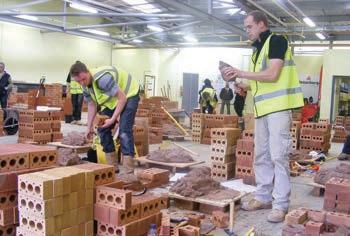

FOR FURTHER INFORMATION ON ETEACH AND HOW YOU CAN GET INVOLVED IN TEACHING THE NEXT GENERATION OF TRADESPEOPLE VISIT WWW.RDR.LINK/BAP023




“ Monitoring your cashflow position is crucial to the success of your business. It enables you to meet your financial obligations and to better plan for the future,” says James Chillman, UK Country Manager for Fergus. “Unfortunately, many businesses have trouble managing cashflow for a variety of reasons, as it’s usually the last thing on their mind at the end of a busy day.”
Utilising a job management system to monitor your cashflow position in realtime allows you to focus on what you need to. It helps to forecast and build sufficient reserves to cope with seasonal ups and downs. From quoting clients to ordering supplies, while juggling multiple jobs and time-consuming admin tasks, means things can get stressful pretty fast. But using a system to keep on top of your cashflow will help ensure your business is staying on track.
FIVE WAYS YOU CAN MANAGE YOUR CASHFLOW:
1Have a financial plan Establishing a budget for the various costs over the year (such as marketing, supplies, transport, wages, etc.) can help to reduce on-the-fly decision-making and allows you to see if you have room in your finances to spend money in a certain area or not.
2Track your money Avoid any nasty surprises by tracking your finances. Knowing where your money is coming from and where it is going to can help you to know where you can cut costs each month or where you may be underquoting without realising. The best way to track your money and stay on top of business finances is with job management software. This software allows you to gain real-time visibility of your business finances at a glance.
3Chase up invoices Your positive cashflow will really suffer if clients aren’t being timely with payments. Aside from gaining a visual into your overall finances, job management software can encourage faster payments from customers by offering a variety of payment options. A platform such as Fergus can also send automatic email or text alerts to remind customers of their overdue payments, all the while giving them the option to select their preferred way to pay. This helps you to get paid on time, speeding up your cash flow.
4Plan ahead
Unfortunately, a lot of tradespeople end up with cashflow issues because they’re owed a lot of money from, not just clients and customers, but also from other construction firms who are lagging on their payments. One way you can save money, time and improve your cashflow is to talk to their suppliers prior to purchasing materials and negotiate their terms. Enquire whether you can get product discounts, return materials that are unused or no longer needed and whether you can get longer payment options.
5Forecast your cashflow Cashflow forecasting involves estimating your future sales and expenses. The aim is to help you predict your cashflow on a month-to-month basis or for the whole year. Forecasting your cashflow can help to recession-proof your business because it will tell you if you’ll have enough money to run your business or expand it in the next 12 months.
Cashflow forecasting manually, without help from job management software, often leaves businesses encountering shortcomings as they don’t have sufficient data to properly predict rapid changes.
In essence, tracking cashflow and implementing a cashflow forecast helps to predict your future incomings and outgoings based on your current known costs and past revenue data.



GO WITH THE Flow

Fergus releases valuable business advice for the trades with five ways to improve your cashflow
FOR A FREE TRIAL OF FERGUS JOB MANAGEMENT SOFTWARE VISIT WWW.RDR.LINK/BAP024






For over 25 years, Grant UK has been supplying award-winning heating products – from the Vortex oil fired condensing boilers to the latest renewable technologies such as solar thermal and air source heat pumps, in addition to wet underfloor heating systems – and developing its range of support services for customers. During this time, the company has significantly grown in size and after trading in Salisbury for a number of years, it moved to Devizes, Wiltshire where its sales, training, technical, marketing and distribution teams have been based since 2003.
Nearly two decades on, Grant UK has undergone further expansion and has relocated to a new site in Swindon. The impressive new facilities are considerably larger, totalling over 80,000sq ft. And in addition to providing greater office spaces and significantly increased on-site storage capacity, the new site has also enabled the supplier’s Training Academy to be expanded as well (with courses available for installers).
With improved facilities and more storage, Grant UK hopes that its new home will allow it to continue to grow, further improving and enhancing its delivery of products and services to customers.
The new Head Office set up has been the culmination of a ten-month renovation project involving the entire site, installing state of the art racking in the warehouses, creating engaging workspaces for employees and transforming one of the units into training rooms and practical assessment areas for the Training Academy.
Sustainability
An integral part of the project was sustainability and Grant UK has implemented numerous environmentallyfriendly measures throughout the site. For example, a biomass heating system has been installed which is providing the heating and hot water whilst 768 solar panels and storage batteries have been installed as part of the 303kWp Solar PV system which has been fitted on the roof of both units – a system which will fulfil all of its electricity demands while also feeding renewable electricity into the grid. The choice of materials which have been fitted throughout the office spaces has also been based on their sustainability credentials. Managing Director Paul Wakefield said: “Our move to Swindon
Grant UK has moved to new premises, with the company’s Head Office, warehousing and Training Academy all now based in Swindon, Wiltshire. A PLATFORM FOR Growth marks an exciting new chapter for Grant UK. Moving premises is a significant step for any business to make, but the hard work that has gone into creating our new larger facilities will enable Grant UK and the team to settle into a site which will support our continued growth for many, many years to come. “The road to a cleaner, low carbon future will be full of opportunities and this move to new facilities will ensure that we as a company can continue to deliver the high-quality products and services that our customers have come to expect from Grant.”
FOR MORE INFORMATION ON GRANT UK’S RANGE OF SUSTAINABLE SOLUTIONS AND SUPPORT SERVICES VISIT WWW.RDR.LINK/BAP025




BUILDING SUCCESS
Joanna Mulgrew, Managing Director of HBXL Building Software, reminds building firms what they’re in business for.

Are you a building firm owner, director or manager? What does success look like to you? Is it a job completed without too much interference from the homeowner? Deliveries arriving when they should? Subbies not letting you down?
It’s very easy for relief to be the overwhelming emotion when a job ends –but let’s not forget why you were doing the extension, loft conversion or new build in the first place – to make money. So, did you?
When we ask our builder community what motivates them – a few goals are regularly repeated – decent holidays, more staff, family time, a nest egg for retirement, off the tools… You know you’re successful when your business is making the kind of money that gives you these well-deserved rewards.
But cash in the bank can be hard to come by. It’s not the number of jobs you do in your working life that will give you the lifestyle you’d like. It’s down to the type of jobs you go after, and importantly, whether you 1) charge the true and accurate amount for the ‘physical’ job and 2) charge for the ‘behind the scenes’ costs.

Software success
An accurate estimate isn’t easy to achieve with pen and paper, or a creaky spreadsheet. Plus, these methods don’t exactly instill the courage needed to charge every last penny for the job – like your management time, a share of the van insurance, the wheelbarrow with a hole, broken tiles and so on.
But you should. Every penny matters. Over time you could lose serious money and certainly not make any. And that’s where estimating software comes in –not as a ‘nice to have’ but as an essential tool of the business.
Accurate pricing
EstimatorXpress for example, tracks the latest prices and works out not just today’s cost but the job start date cost as well –useful bearing in mind the continuing price increases. Material schedules are produced automatically so suppliers get advanced notice. And the onboard Gantt chart will also take a date change in a job and cascade the consequences.
But perhaps better still, are the nudges EstimatorXpress gives the user to charge the full amount and not round down, or knock a few hundred quid off. Firstly, it calculates every single hour, every last nail and tube of mastic, and it knows all the plant you’ll need and for how long.
Secondly, it gets you to think about the cost beyond materials, labour and plant. Give it a percentage for your overheads and it will do the sum, same for the wear and tear, wastage and inflation. Go with it. Trust the process. There are customers out there who will pay the right price for quality craftsmanship and a professional service. And they are the ones with the projects that help building firms expand and grow.
And these in-depth calculations don’t mean more work – the opposite. Over the last few years EstimatorXpress has been re-engineered to be even more straightforward for the user. The whole process is ‘step-by-step’ with visual aids and hints and tips that appear in the window as you go. An extension can take less than hour, a new build no more than a few hours.
Uncapped support comes as standard
YOUR CHANCE TO WIN !
A YEAR’S SUBSCRIPTION TO ESTIMATORXPRESSS PREMIUM WORTH £699+VAT MUST BE WON!
EstimatorXpress, with its different editions, is for everyone from start-up building firms, small and medium sized businesses, all the way through to property developers.
And they all have their own reasons for using the clever estimating software. Saving time on estimating... improving accuracy and avoiding costly errors... latest material prices... protecting bigger profits... valuable reports from cash flow to material schedules... presenting a professional image to win quality jobs... businessimproving analysis...
FOR FULL ENTRY DETAILS TO THIS FANTASTIC PRIZE USE THE RDR.LINK BELOW TO GO STRAIGHT TO THE PROFESSIONAL BUILDER WEBSITE WWW.RDR.LINK/BAP026
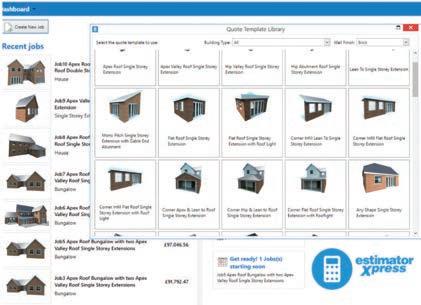

All new users receive an onboarding session, help with their first estimate, and have the option of eight free hours of live-streamed training to sharpen their new found skills if they feel they need it. Telephone support is included in the first year as part of the software package, thereafter there’s a small annual fee for support and software updates.
So isn’t it time to charge the full amount for your work… and build retirement, nights off, a family holiday, a bigger office, a new van… into your future?
Don t miss YOU CAN PUT ESTIMATORXPRESS this...
TO THE TEST DURING A FREE 14DAY TRIAL –DOWNLOAD IT INSTANTLY FROM THE HBXL WEBSITE AT WWW.RDR.LINK/BAP027

SUPPORTING BUILDERS
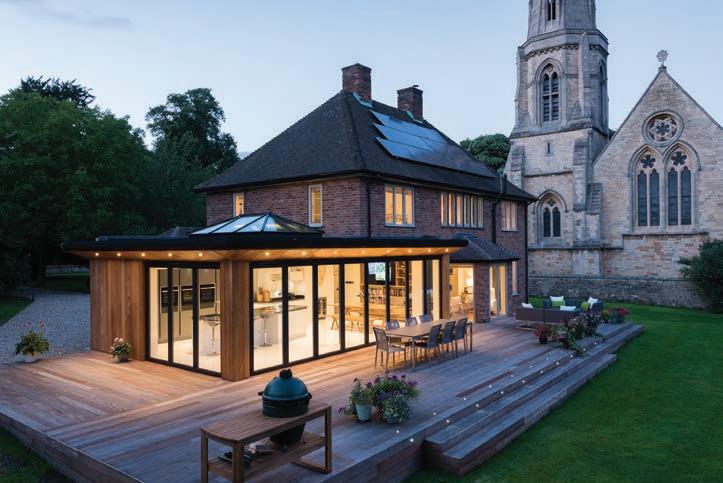
The UK construction industry has had to battle against unprecedented challenges over the past two years. Unfortunately, rather than getting easier, it is predicted that we will be entering the eye of the storm in the year ahead.

Ben Brocklesby, Director at Origin, anticipates the biggest hurdles are yet to come and explains how, as one of the UK’s most successful manufacturers, Origin has updated its operations to help professional builders weather the storm.
Overcoming Materials Shortages
According to the Construction Products Association, the cost of building materials increased by an eye-watering 42 percent at the end of 2022. Supply chain issues caused by the pandemic, Brexit and the war in Ukraine have pushed prices up dramatically, while over 90 percent of builders have experienced project delays due to shortages, according to NAHB.
The only way to prevent this happening is to work with manufacturers that have safeguarded their operations against global shortages. At Origin, we have heavily invested in our internal infrastructure to guarantee our we can deliver our products within just 24 hours of an order being placed.
A 55,000sq ft warehouse facility, opened in 2021, is now home to an abundant reserve of aluminium profile. By futureproofing the business against economic and environmental uncertainty, we have created our own robust supply chain. This ensures we can always supply systems to our Partners. The warehouse, known as ‘The Ark’, has also increased manufacturing capacity for greater productivity at our other facilities.
Additional changes to our internal IT infrastructure have also been made to support Origin’s ‘On Time, In Full’ delivery promise. As part of our ‘one-click’ vision, we have automated our internal processes so that when an order is placed via our revolutionary online software, Origin Sale Safe (OSS), stock is automatically reordered to replenish the warehouse. The order is processed without any human involvement for complete reliability.
All areas of the business have invested in change to protect Origin’s delivery promise. The R&D department, for example, has even redesigned systems to remove materials that will be in short supply in the future.

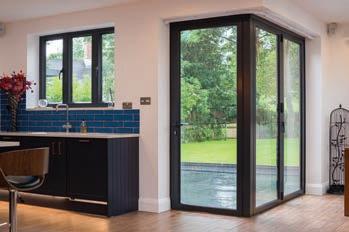
Achieving Future Homes Standard
A dramatic rise in the cost of gas and electricity, plus the introduction of ‘Part L’ of the Future Homes Standard, has propelled the thermal performance of homes to the top of the priority list. In new homes, windows and doors must achieve a U-Value of 1.2 W/m2K, while replacement
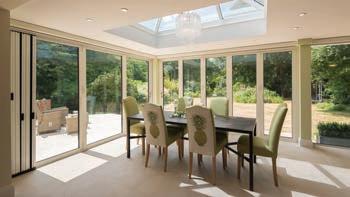
systems require a U-Value of 1.4 W/m2K.
U-Values and Window Energy Ratings (WER) need to be explained to homeowners to help them make an informed decision and ensure they invest in glazing systems that meet the new criteria. While some manufacturers have opted to offer triple glazing as standard to achieve the latest regulations, they might struggle to meet the stricter targets when they are introduced in 2025.
We have invested in innovation to ensure the highest level of thermal performance, without compromising functionality or style. In the year ahead, the Origin R&D department will be further updating all systems with clever design features to ensure they exceed the targets set out in the Future Homes Standard in 2025.
Supporting Growth
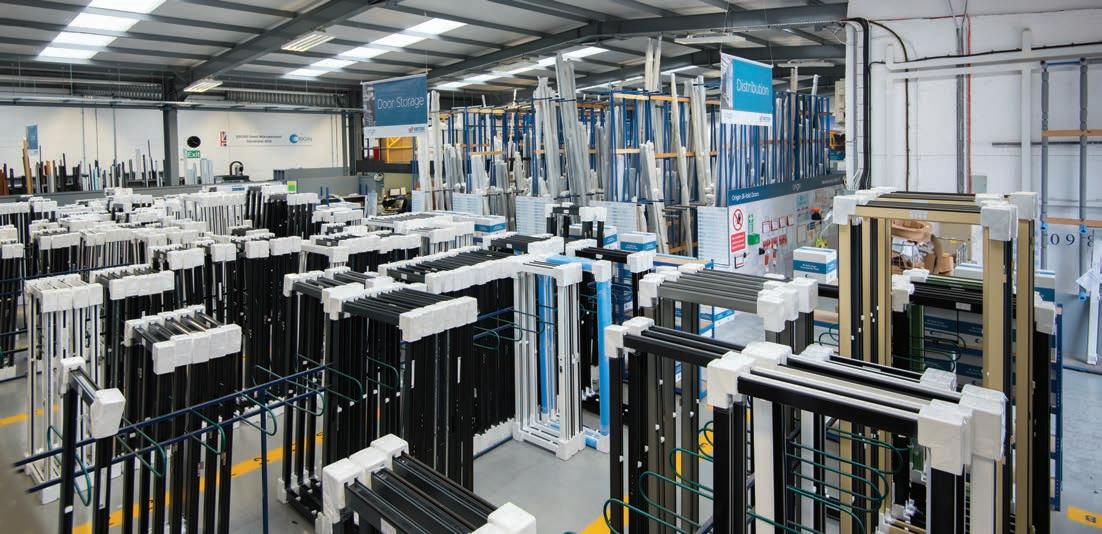
For professional builders to be able to successfully grow during challenging times, it is vital that they are supported by their manufacturing partners and suppliers.
Origin Sale Safe (OSS), our ordering and quoting system, allows Partners to quote and order whole house projects in minutes. Adjustments can easily be made at any stage and the system will immediately provide a revised quote.
Updates to the software in 2023 will allow our Partners to automatically add their margins onto the cost of a project and quote for intricate projects quickly and easily online. By offering an efficient and accurate ordering system, we can save them valuable time to support their business growth.
In the words of Henry Ford: “obstacles are those frightful things you see when you take your eyes off your goal”. Even through the pandemic, Brexit and a UK recession, Origin has remained committed to service excellence and growth. Challenges provide us with the opportunity to adapt our business to offer an even greater level of support.
FOR MORE INFORMATION ON THE RANGE OF PRODUCTS FROM ORIGIN VISIT WWW.RDR.LINK/BAP028
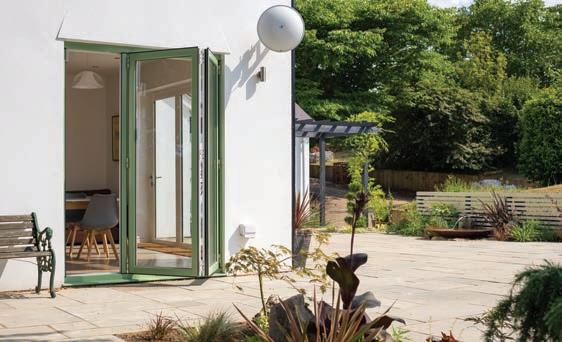
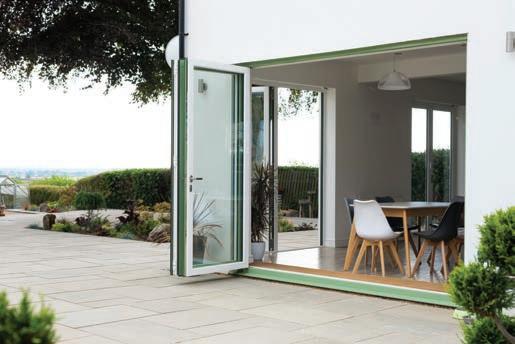

Marley is offering some seasonal advice on how to keep safe on site this winter

WINTER WARMERS

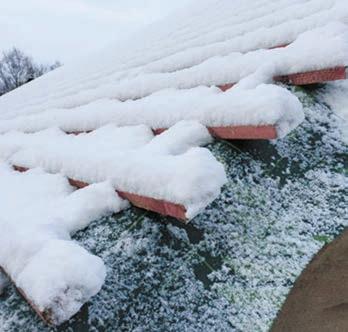
Here in the UK, very harsh weather – from torrential rain and wind to freezing temperatures and snow – is not uncommon during the winter months. Add to that the speed and unpredictability that conditions can change and you’ve got potentially serious issues for those working on site, especially at height.
Although we cannot avoid what nature throws at us, Marley is urging professional roofers to fully prepare for the difficult working conditions that come hand-inhand with the winter months, with its ‘Winter Safety’ campaign.
Be alert
Construction sites are hazardous environments, with heavy machinery and power tools in constant use and, of course, people working at height.
Winter has the potential to get nasty, with temperatures plummeting to below zero, heavy rainfall plus strong winds to contend with. For roofers, who are highly exposed on site anyway, winter can have a significant negative impact on their health, safety and wellbeing.
Daniel Redfern, Marketing Manager at Marley said: ‘With roofing contractors working for long periods of time outdoors, often in difficult and dangerous weather conditions, we are committed to providing useful, straight-forward advice, highlighting the risks and showing how to minimise them.
‘The good news is that, with a little preparation, the effects of working under harsh winter conditions can be greatly minimised. Making sure you’re aware of what’s coming weather-wise will help you prepare for your time on site.’
BE AWARE
Preparation is vital for a safe and successfully operational site, with three key areas to consider:
■ Watch the weather
Make sure that the weather forecast is monitored on a daily basis so that any poor weather is anticipated and action, if required, is taken. Essential for roofers, working at height platforms and roofs should be regularly checked for ice. If ice is present, work should cease immediately as this is a requirement of the Working at Height Regulations 2005.
In addition, it is worth checking windspeed with a hand-held anemometer, as recommended by the HSE, to avoid dangerous gusts of wind causing falls.
■ Keep the heat in
Lower temperatures mean that additional clothing is essential to help counter the impact of cold on the body. Rapid heat loss or reduction in body temperature over time can lead to serious illness and downtime.
Wear at least three layers of clothing –
a base layer with moisture-wicking properties to draw sweat away from the body; a middle, breathable layer to help insulate and a good wind/waterproof outer layer, that fits well, allows for a full range of movement and gives good elemental protection.
Wet clothing should be changed immediately, whilst gloves should be worn at all times, especially when using ladders or scaffolding as frostbite can occur immediately if extremely cold metal is touched with bare hands. Finally, it is essential that hot food and drinks are consumed throughout the day to help keep the body’s core temperature at a healthy level.
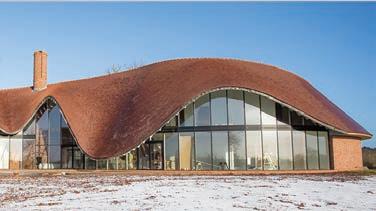
■ Avoid slips, trips and falls
When a surface, such as a scaffolding platform or roof becomes cold, ice can form and present a major slipping hazard, with height only adding to the danger. Such areas need to be treated to avoid slips, trips and falls.
Clearing icy patches with salt or sand improves traction and should be applied when and where needed, whilst extra care should be taken when carrying tools and materials.
Sturdy footwear – such as robust waterproof boots with nonslip soles – should be worn, with warm thick socks for added protection.
KEEP WARM THIS WINTER WITH MARLEY There’s a host of useful winter safety advice available on the Marley website, plus the opportunity to receive a Marley snood and beanie hat, to help keep you warm this winter. To receive yours simply provide your details at:

WWW.RDR.LINK/BAP029
FOR FURTHER DETAILS ON MARLEY’S WINTER SAFETY CAMPAIGN VISIT WWW.RDR.LINK/BAP030

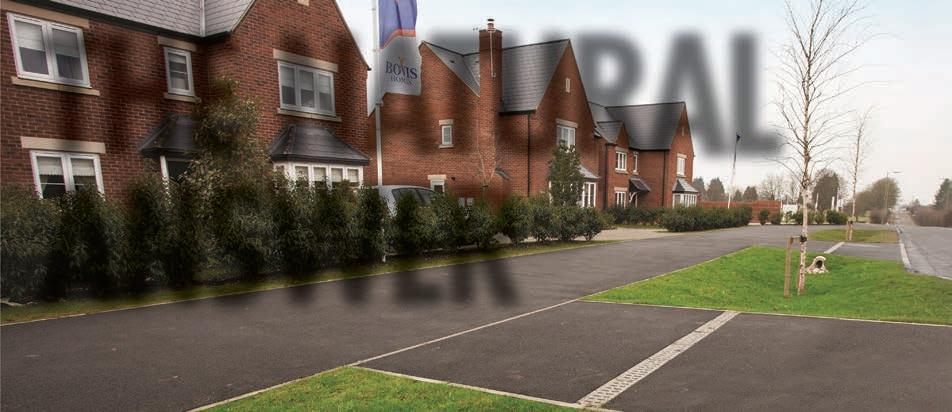
THE NATURAL ANSWER
Adam Cane, Sustainability Lead at ACO Water Management, looks at how we can build better by boosting biodiversity
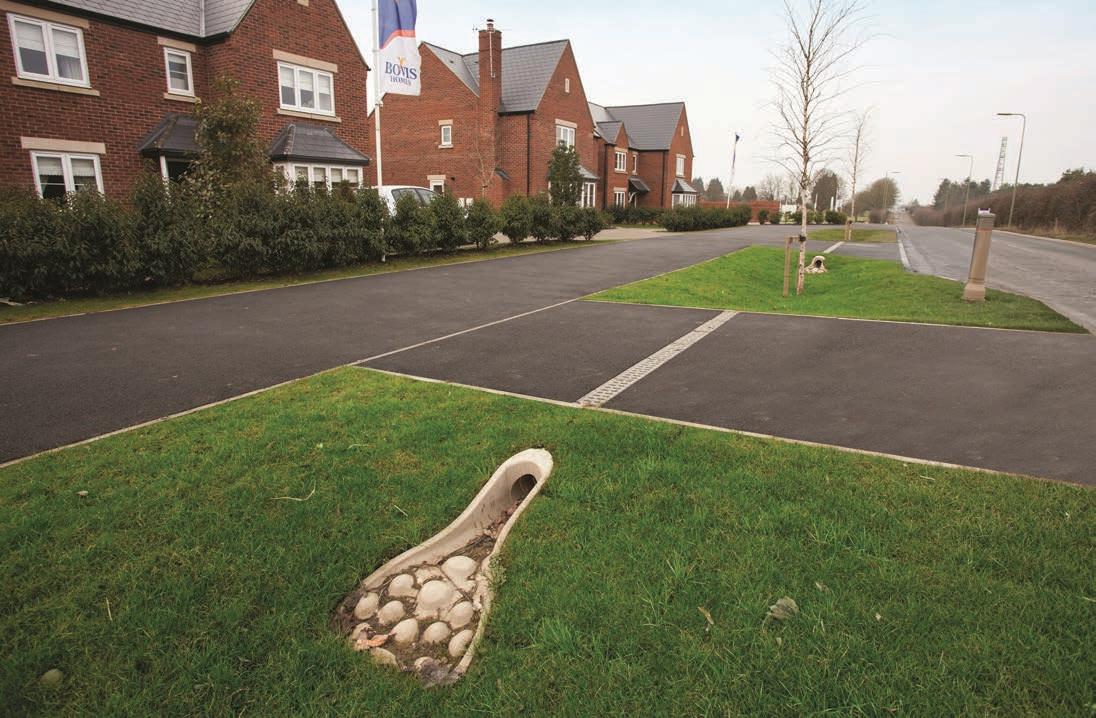

Biodiversity depletion in the UK may not come as a shock. Since the Industrial Revolution, Britain has lost over half of its natural biodiversity. There is still a need to build more infrastructure as human populations continue to grow which, in some cases, has a negative impact on nature where construction leads to land loss, fragmentation and degradation. This is pushing many species and ecosystems into decline and some to the brink of extinction.
To understand the vulnerability of species, we need not look any further than the humble hedgehog. According to the National Biodiversity Network (NBN), in the past 20 years, up to 75% of Britain’s rural hedgehog populations have disappeared and are considered vulnerable to extinction with road networks, urbanisation and fragmentation considered major factors.
According to the 2021 River Basin Management Plan more than 10% of freshwater and wetland species are currently in danger of going extinct. This is linked to the decline in wetland ecosystems which have decreased 90% during the past 100 years in the UK. A likely culprit for the decline could be the fact that just 16% of England’s water bodies are in a good ecological state (GES) due, not only to water discharged by water companies, but also oil, hydrocarbons, metals and plastics discharged to the natural environment from the connected road network and separated surface water systems. Pollution of this sort has a massive negative effect on nature and people and has not yet been properly quantified.
Changing a landscape from its natural state and replacing it with hardlandscaping can also increase the likelihood of floods, potentially having a severe impact on people, infrastructure and nature. As a result, reversing the influence the built environment has on the natural world, mimicking natural systems and supporting nature-based solutions (NBS) is now more important than ever. The industry must balance the need to reduce carbon emissions with a duty to protect and enhance the natural world. Housebuilders are able to play a special role in changing things for the better and providing better outcomes for homeowners and broader society.
Footprint only construction
For the above to work, the natural environment needs to be left as intact as possible. Leaving soil undisturbed is best for nature but necessary for building. The reality is that soil health has degraded globally, likely due to frequent building works. Disturbing soil releases a significant amount of naturally stored carbon into the air and disrupts the normal activity and lifecycles of native plant, bacteria and animal life, all of which play a vital role in fortifying natural biodiversity.
Where disturbing soil is unavoidable, the top 150mm – where the majority of life is – should be kept safely and stored or used elsewhere on site. Any vegetation should be kept in natural areas of the site for biodiversity to find refuge. Developers should also consider temporary fencing wherever possible to protect nature from making unwanted ingress.
Pollution reduction
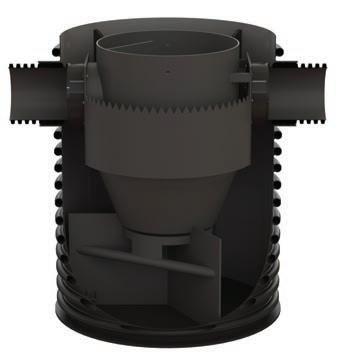
Every living organism needs water to survive. Preventing toxins on roads from washing into waterways and neighbouring habitats is one technique that has a positive effect on the environment and regulating the quality of runoff is crucial, serving as a fundamental rule of sustainable drainage systems (SuDS). Water treatment systems like ACO’s V-Septor (Hydrodynamic Separator), Q-Ceptor, or QuadraCeptor solutions can be put in place before water is discharged into swales and ditches in SuDS schemes. These are vital additions because natural resources can only purify water so far and should be allowed to function and grow as nature intended.
The V-Septor, for example, is designed to capture sediment bound contaminants and floatables by directing incoming stormwater to make a vortex, slowing the water so the suspended solids settle down in the sludge chamber. Baffles work as barriers to keep sludge and suspended plastics in the chambers rather than flowing back out during periods of heavy rain. Once cleaned, water can move through an outlet back into the environment. Remaining debris can be easily removed during regular maintenance.
To specify such SuDS systems and understand the impact of different site developments, housebuilders can use the Simple Index Approach (SIA) as set out in the CIRIA SuDS Manual, in collaboration with water management experts and manufacturers. By doing so, housebuilders can assess if a SuDS design offers sufficient protection against pollution dangers such as tyre rubber, lubricants and heavy metals from automobiles etc.
The use of SuDS in both new builds and retrofit projects should be embraced by developers. Runoff from hard surfaces can be captured by SuDS features such as bioretention zones, rain gardens, swales, and tree pits supported by proprietary cleaning products. By making developments more hospitable areas for people to live, work and enjoy recreational activity helps enable positive engagement with the natural environment.
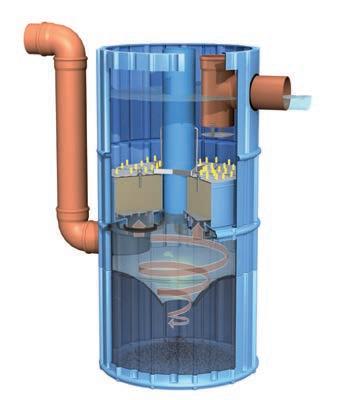
QuadraCeptor
V-Septor
Increasing biodiversity

To ensure that we protect key species we must first examine the local ecosystem before beginning any construction work. The Environment Act 2021 makes it clear that new developments in England must demonstrate a minimum 10% Biodiversity Net Gain, making systems like SuDS and the use of Nature Based Solutions (NBS) increasingly necessary. A new SuDS scheme should connect with other local and/or regional habitats to help create and strengthen habitat connectivity, according to recommendations in CIRIA’s SuDS Manual.
Each site is different but there are a range of products on the market, such as wildlife kerbs, guide tunnels, and escape ladders which can help integrate wildlife mitigation measures. These features can aid mammals and amphibians in safely navigating road networks and mitigate entrapment or fatalities. There is also the opportunity to create refuges by integrating bird boxes, bat boxes and bug hotels into houses.
Engagement opportunities can be created, and housing projects can be connected, using the Habitat Matters Mapping System. A free tool that enables the replication of the physical environment, connecting users to the built environment asset using a QR code. The Habitat Matters Mapping System makes it possible to submit biodiversity observations that contribute to national record keeping. Housebuilders have the opportunity to go beyond simply offering products and systems by better connecting people to infrastructure and nature.
Built to succeed
As an industry, we have the knowledge, technologies and tools to build better environments where people and wildlife can flourish. The loss of habitats can start to be reversed through design. ACO possesses a range of expertise and can provide a free consultation, design service or Continued Professional Development (CPD) to help create sustainable drainage.
FOR MORE INFORMATION ON THE ACO RANGE VISIT WWW.RDR.LINK/BAP031
POOL OF
Anderton Concrete’s Stepoc concrete shuttering system has delivered the perfect finish for a natural pool construction
Knowledge
When award-winning natural swimming pool builders, Ellicar, required an efficient method of construction for an installation in the gardens of a listed property located on the outskirts of Kent, it turned to Anderton Concrete for the answer.
The natural pool’s design incorporated a swimming area separated from dedicated regeneration zones via low submerged walls, with each regeneration area containing water plants which help to naturally filter and purify the water, keeping it hygienically clean and crystal clear.
Having designed and installed natural pools for over 20 years, founder and owner, Sarah Murch, required a resilient solution that would not only deliver impressive longevity, but simultaneously meet her specific design requirements, whilst keeping to project timescales.
In order to successfully construct the reinforced concrete chamber for the 15metre long x 4metre wide x 1.8metre deep swimming zone, Sarah specified Anderton Concrete’s unique concrete shuttering system following a recommendation from a structural engineer.
Consisting of precast concrete blocks that weigh less than 20kg each and can be both vertically and horizontally reinforced, the use of Stepoc enabled Sarah’s team to quickly and efficiently build the entire pool wall structure in just three days.
Streamlined installation
To streamline the installation process, Sarah partnered with the manufacturer’s technical team to tailor the structure’s design to the dimensions of each Stepoc block, working to a full course. Each block sits over a L shaped rebar which is cast into the concrete raft. Then as each course of the 900 concrete blocks was installed horizontal rebars were fitted to provide additional reinforcement. The finished walls were filled with one single concrete pour.
Speaking of the project, Sarah said: “With any natural pool build, it’s crucial that the structure provides not only a perfect, smooth finish for the pool’s flexible liner but also the exact finish for us to install the hard landscaping around the water’s edge including architectural stone paving, wooden decking and internal coping. Being able to tailor the design of the walls to the dimensions of each Stepoc block ensured we achieved this, streamlining the entire process.
“Having never used Stepoc before, myself and my team were extremely pleased, both with the initial installation process and the overall quality of the finished construction. So much so that we have already specified the system for another two upcoming projects and are modelling our pool construction designs accordingly.”
Once the concrete structure was built, Ellicar’s pool team lined the entire pool with a waterproof, flexible TPO liner, followed by special aggregates into which the water lilies, deep aquatics and marginal plants such as irises and watermint are encapsulated. In addition,
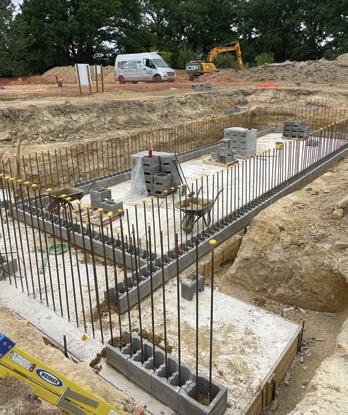
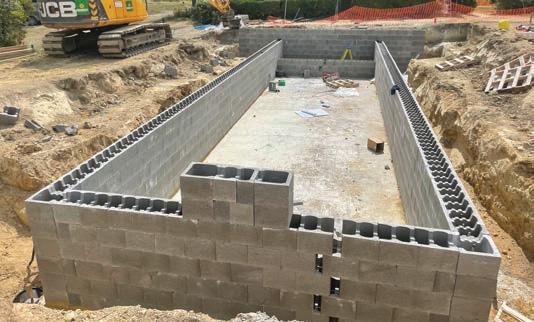
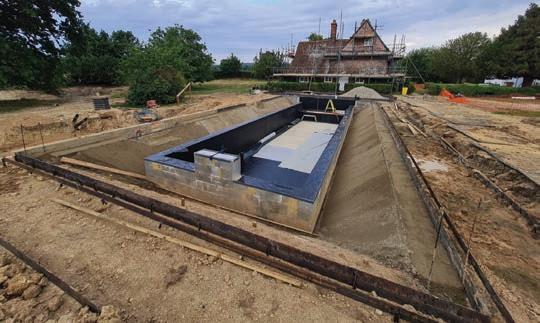
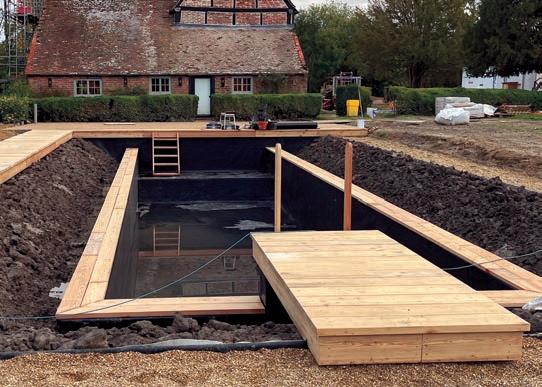
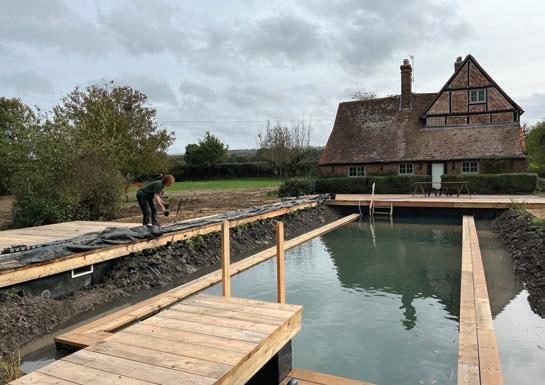
the pool is fitted with Biotop’s biological filtration system. The pipework from the filters and pumps being brought through flanges in the walls, which were installed at wall construction stage. The filter chamber is covered with a wooden deck with access hatches.
Tim Fields, Structural Products Manager at Anderton Concrete, said: “Combining the ease of blockwork with the versatility of in-situ concrete, Stepoc maximises on-site safety and efficiency, whilst minimising installation costs.
“Whilst Stepoc has been specified on a range of swimming pool projects over the last two decades, this is the first time the system has been utilised to construct a natural pool structure and the results really do speak for themselves. It was fantastic to collaborate with the Ellicar team on this project and I look forward to working with them again on upcoming builds.”
A popular choice for a diverse range of single-skin retaining wall requirements, Stepoc has been proven to be one of the most cost-effective methods of construction. Following independent analysis, it has been proven to offer a substantial cost saving of over 30% when compared with in-situ concrete, whilst delivering an approximate saving of 20% against cavity block construction.
The innovative system has also been awarded the British Board of Agrément (BBA) Certificate 20/5774, evidencing Anderton Concrete’s first class engineering excellence and dedication to supporting industry professionals in achieving a world-class built environment.

FOR FURTHER INFORMATION ON ANDERTON CONCRETE VISIT WWW.RDR.LINK/BAP032

MAKING THE GRADE
Shaun Revill, Trading Director at SR Timber, sounds the alarm on ungraded battens.
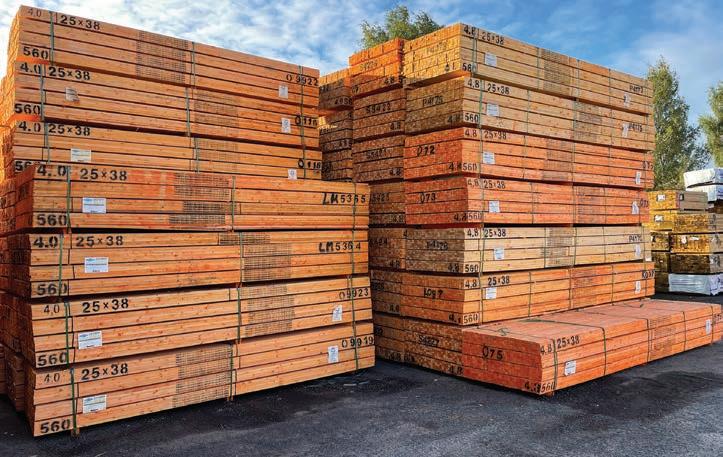
The emergence of ungraded batten being passed off as graded poses a real danger to those working with them. As a result, it has become critical roofing contractors pay close attention to what they’re purchasing, and physically checking the battens are a British Standard product.
Over the past few months there had been hints of this ungraded batten being passed as true graded at ports, and evidence is mounting that this stock is appearing in merchants. It’s a product that’s dimensionally undersized, with knots outside of allowed tolerances, and would have failed standard quality controls checks by a legitimate producer.
Ben Hulme is one roofing contractor based in Halifax who raised the issue with NFRC. While subcontracting on a housing project, he was supplied with batten stock to work with and discovered ungraded mixed into the delivery. “I turned up on site and was taken to the stock of batten so I could prepare for the job – it’s at this point I immediately saw a problem”. Mixed in amongst graded blue batten were lengths of timber clearly not to specification.
“I could tell straightaway some weren’t right,” continues Ben. “I’ve trained my entire career to spot a graded batten and some of the lengths were smaller, knots larger than tolerance allowed, and it was all mixed in with what looked like proper graded blue battens.”
To pass the timber off as conforming to BS 5534, it looked like the producer had painted the battens blue instead of the correct treatment method. “Whatever process they used to colour the batten was clearly a shortcut. It didn’t look like it had been properly treated with a colour dye at the production stage”.
“I typically buy my graded roofing battens from larger, more reputable suppliers whereas this batten had been bought from a merchant putting profit ahead of quality and roofers’ safety. It’s frustrating because I’m having to deal with rising prices which either eat into profit or I have to raise my own prices. Then on top of that, the quality just isn’t there. I’ve had tiles not curing right, lead being bent, and now blue batten that just isn’t up to standard.”


Image courtesy of Ben Hulme
Spotting the signs early
Simon Dixon, Training Manager at NFRC, is equally frustrated. With more NFRC members coming forward, he rightly highlights the importance of proper training and recognising what makes a graded batten: “Seeing ungraded batten being coloured blue and passed off as proper graded batten is disheartening. It means the product is being sent out to site that isn’t fit for purpose in the first place. It goes

Image courtesy of Ben Hulme. Batten was removed from roof after installation.
to highlight the importance of understanding the grading process and what makes a batten conform to BS 5534.”
Using substandard batten puts contractors lives at risk, increasing the chance of something going wrong during the build. All graded battens should be dimensionally accurate –BS 5534:2014 + A2:2018 allows for a tolerance of -0mm / +3mm on the thickness, (25mm), and -3mm / +3mm on the width (which will be 38mm or 50mm). The strength of the batten is dependent on slope of grain, number of growth rings, quantity and dimension of knots being within regulations.
Simple checks such as measuring if the thickness is 25mm can quickly identify if a batten is fit for purpose. If under 25mm, the batten will fail to pass the British Standard allowed tolerances and isn’t a true graded batten.
Why now?
We think the problem is partly down to the increasing pressures we are all faced with. As costs rise across the board, some suppliers are turning to this cheaper, compromised product to ensure a healthy margin. Consequentially, there is an erosion of trust in these suppliers and the market. Contractors are buying this product thinking it’s treated correctly, showing the colour and being stamped. All indications of a true British Standard product when its clearly not.
I’ve worked in and have been connected to the industry my entire life, and I want merchants and contractors alike to be aware of these issues. These markings and checks are here for a reason, and roofers’ safety is at the top of the agenda.
Larger suppliers such as SR Timber offer a legitimate British Standard product, ticking all the boxes when it comes to quality and allowed tolerances. Above everything else, I urge all merchants and contractors to challenge when they spot something they believe isn’t right.
FOR MORE INFORMATION ON GRADED BATTENS FROM SR TIMBER VISIT: WWW.RDR.LINK/BAP033

If you’re looking to gain new experience this year and take your business to the next level, why not become a VELUX® Certified Installer? With the option to train online, or in person, VELUX® can help you to grow your skills towards becoming a trusted Certified Installer.

At VELUX®, we believe it is important to provide training to all installers, to understand the benefits of more efficient roof window installations and keep you up-to-date on the latest innovations. Through the VELUX® Certified Installer scheme, we connect homeowners to the very best installers in their area, actively promoting our trusted Certified Installers.
JOINING THE SCHEME WILL OPEN A
RANGE OF BENEFITS, INCLUDING: • Bespoke sales leads, allowing you to choose the geographical radius you would like to cover and type of leads you will receive (new installations, roof • window replacement, etc.) A powerful partnership with Trustmark, the only government endorsed scheme • for tradespeople in the UK Listings on the VELUX® and
Trustmark websites receiving • thousands of hits per month The opportunity to gain an endorsement from a market-leading brand
Installer training courses combine practice and theory and are designed to help you move your business forwards. Stay updated with the newest developments of our roof windows and accessories, the best installation practices, as well as the commercial insight to better sell the VELUX® range and increase your profits.
Choose between physical training: quick and efficient option with a range of courses, or online training:
WWW.RDR.LINK/BAP035 at the online VELUX® Training Academy, a convenient way to develop your knowledge of VELUX® products and how to correctly and efficiently install them, wherever you may be.
VELUX® also offers bespoke training sessions and has the option of coming to you for your added convenience, subject to conditions. Both forms of training will help you with tested techniques and tips, whilst learning about new VELUX® products and innovations before they come to the market. Increase your confidence of the complete VELUX® range and boost profits through improved product knowledge.

WWW.RDR.LINK/BAP034 at the two VELUX® Training Academy locations, a HOW TO APPLY: To ensure the quality of our Certified Installers, the application process involves an onsite assessment of a standard VELUX® installation, officebased checks on your trading history, and references from previous customers.
Annual membership is £125.00 plus VAT, which can be paid either in a lump sum or on a convenient monthly direct debit.
If you’re looking for a direct seal of approval from the UK’s leading roof window manufacturer, complete the form here: WWW.RDR.LINK/BAP036 and an application manager will be in contact to guide you through the process. Take the first step to becoming a VELUX® Certified Installer, with this exciting new step in your career, today.

IN THE FRAME
Athird showhome created by timber-frame specialist Scandia-Hus and insulated with Actis Hybrid products has achieved an impressive suite of energy efficiency and environmental performance parameters.
Its performance is captured in the asbuilt SAP calculation, which reveals an improvement of the Dwelling Emission Rate of 35% over the notional building specification and an improved Fabric Energy Efficiency rate of 24.5%.
The 2,755 sq ft three-bedroom chalet bungalow at Scandia-Hus’ Sussex premises also achieved an energy efficiency rating of B. And it has an impressively low level of air permeability, achieving an air leakage rate of 3.25 m3/hm2 at 50Pa, with this number of air changes per hour falling way within the Building Regulations’ limiting or notional values of 10 and 5m3/hm2 @50Pa respectively.
The UK’s largest designer and supplier of Swedish energy-saving timber-framed homes was so impressed by the thermal efficiency achieved in the first two showhomes it built at its Sussex HQ that it replicated the precise specification it used on those buildings for its latest creation.
The home offers the same U-values achieved in the initial two buildings – 0.14 in the roof and 0.16 in the walls thanks to the installation of vapour control layer HControl Hybrid and 155mm honeycomb design Hybris in the pitched roof and HControl Hybrid and 105mm Hybris in the walls. The eco-friendly property runs on an air source heat pump, and the sustainably sourced timber used creates an air-tight structure.
Actis regional sales manager Liane Bayliss said: “Actis Hybrid products are particularly popular with timber frame manufacturers. Giving a hands-on demonstration of the various elements used in a build of this nature will be very educational, both for the potential buyers of Scandia-Hus properties and for specifiers keen to explore different insulation products and their benefits for other build projects.”
Scandia-Hus trialled the Actis Hybrid system a few years ago on its first, contemporary style, show home, carrying out a thermal imaging exercise after completion to help determine whether to switch to using the system for future projects. The results, which showed an impressive lack of thermal bridging, convinced them that this was the best insulation for most of the homes it builds every year.
MD, Derek Dawson said: “Using Actis reduced installation time by up to 30%. Previously, insulation was installed in two phases – the first in the factory and the second on site after the first fix was complete.
“Actis Hybris is easy to install. The panels are easy to cut to exactly the right size so they simply slot into the stud wall. Due to the use of service voids and the ease of installation, the insulation will now generally be installed in one phase on site. This also ensures that the air tightness of the building is not compromised by followup trades. Other benefits were minimal wastage and site cleanliness. And as if that is not benefit enough, the Hybrid range does not produce irritant and messy dust when installing.”

The Mulberry is the third Scandia-Hus showhome to be insulated with Actis Hybrid products. The as-built SAP calculation showed its Fabric Energy Efficiency rate is nearly 25% better than the target FEE.
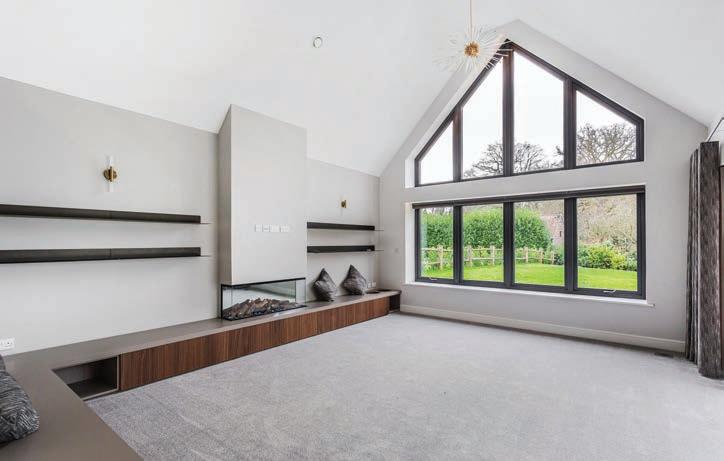
SAP reveals impressive energy efficiency of third Actis-insulated property

TO DISCOVER MORE ABOUT THE ACTIS HYBRID RANGE VISIT WWW.RDR.LINK/BAP037
SUSTAINABLE CHOICES

Peter Jackson of Jacksons Fencing predicts that construction company owners will focus more on sustainable materials, public safety, and ways to maximise value in 2023.

From a greater demand for security fences to more ecofriendly finishes, a few critical changes will impact fencing decisions for builders this year. For firms working on residential properties, or developing commercial sites, being prepared for a tough year of materials and labour shortages –and rising costs –will pay dividends, as will recognition of some important emerging issues. Here are my trends predictions for 2023, with some tips on how to address security correctly for your upcoming builds:
Sustainability and protecting biodiversity
Sustainability is at the forefront of building sector conversations, and businesses of all sizes are facing more intense pressure to improve their sustainability initiatives and achieve carbon reductions. In 2023 Ministers will launch a consultation on implementing a proposal from the Environmental Audit Committee (EAC), which has the potential to address the source of 25% of the UK’s greenhouse gas emissions – from the built environment.

WWW.RDR.LINK/BAP038
Eco-friendly
As a new legal framework for net zero in the built environment is drawn up, it’s important that sourcing more sustainable materials for new builds becomes the norm. When it comes to security and perimeter measures, look for eco-friendly, sustainable fencing and gates which uses responsibly sourced and regulated timber.
The right species of timber for the purpose should be selected by manufacturers before the all-important preservative treatment, design, and construction process. If all these elements are right first, then any sustainability/ responsible sourcing certifications have a more meaningful context as the best use has been made of the timber, and a product that provides a long life ultimately means less deforestation.
WWW.RDR.LINK/BAP039
Value and carbon-efficiency
A major trend that is affecting the UK is the cost-of-living crisis which will likely become a recession. Many businesses will increase their level of perimeter security to help prevent an expected crime level increase. Commercial property new builds may need to have this factored in. Specialist fencing for high value residential properties may also be a wise consideration by builders.
When it comes to decisions around perimeter fencing for residential and commercial property developments, there’s recognition now that lower-quality panels and gates are less sustainable, and probably more expensive in the longrun. This is because replacements and repairs are more likely, increasing waste. In 2023 as recession bites, we will see construction firms and professional builders thinking carefully about the lifetime cost of fencing and gating solutions, looking beyond upfront product costs, to get the best value and lowest carbon impact in the longer term. The length of the guarantee matters.
WWW.RDR.LINK/BAP040
Hedgehog Security Fencing
Protecting nature and the environment on sites matters too. If you can introduce things like hedgehog-friendly security fencing, so much the better! Vertical bar fencing ticks all the boxes when it comes to security and hedgehog preservation. Featuring pales spaced to conform to anti-trap regulations, hedgehogs have more than enough room to pass between the pales to the other side.
WWW.RDR.LINK/BAP041
FOR FURTHER INFORMATION ON JACKSONS FENCING VISIT WWW.RDR.LINK/BAP042
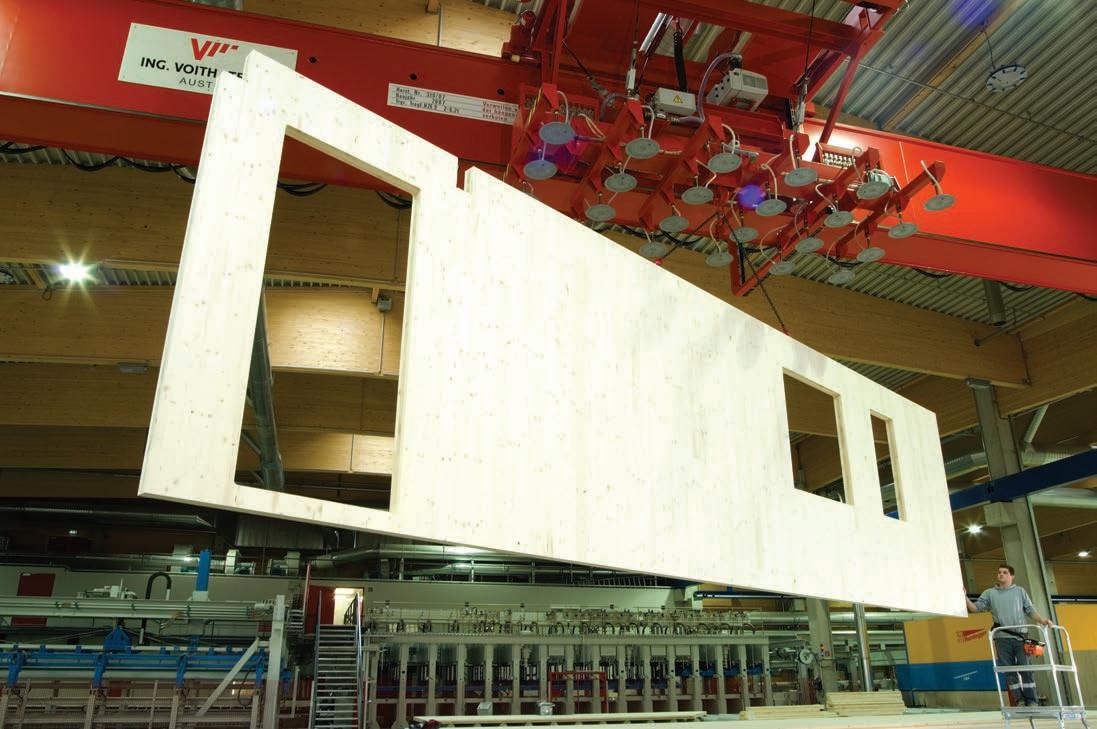
Cross-laminated timber (CLT) has become a popular choice for designers over the last 15 years. Spanning residential buildings to educational and commercial spaces, the market growth of CLT can be attributed to its usability in complex timber structures. Modern lightweight timber frame buildings have been used for nearly 100 years. Plus, a large proportion of the UK housing stock has timber pitched roofs, many of which are centuries old.
WEATHERING
THE STORM CLT has also created exciting opportunities for low/negative carbon and sustainable buildings. However, as with all construction products, there has been a learning curve as the industry’s understanding of CLT’s strengths and Phil O’Leary, weaknesses has grown. One such area where new knowledge has beenTechnical uncovered is in how moisture can Manager at BM compromise the material’s durability.
TRADA, explores how moisture CLT durability
dynamics can Durability of construction materials and affect the durability of cross- components is particularly important as more people talk about sustainability. Thelaminated timber, covering benefit of timber and wood-based the latest research from BM products is that the lifespan can be almost TRADA and Stora Enso. indefinite if they remain dry. That said, timber is at risk offungal decay if its
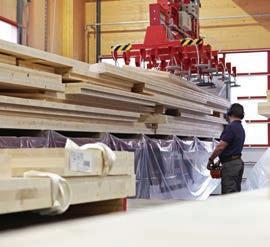
moisture content exceeds 20% for an extended period of time. In a welldesigned and constructed timber frame building or pitched roof, moisture content in service will be between 10% and 14% –well below the fungal decay threshold.
While CLT follows the same durability principles as lightweight timber structures, its thickness and the mass of timber used present additional considerations when exposed to moisture. Timber studs, joists and rafters have a relatively large surfacearea-to-volume ratio and so typically dry rapidly when conditions allow. On the other hand, CLT has a much smaller surface-area-to-volume ratio and so drying rates can be substantially slower, which can affect durability greatly.
Insulation considerations
CLT external walls and roofs should always be designed as ‘warm’ construction. This means all thermal insulation is placed on the outside face of the wall or roof panel. By placing the CLT panels within the thermal envelope of the building, panels are in what should normally be a warm and dry environment – creating the ideal environment for timber to endure.
The most common insulation material placed on the outside of CLT in the UK is rigid foil-faced insulation boards (e.g. PIR/PUR/phenolic). It is installed to walls, flat roofs and pitched roofs. While these insulation materials have excellent thermal resistance and provide the required U-values, the foil facings limit drying of the CLT panels behind.
Developing understanding
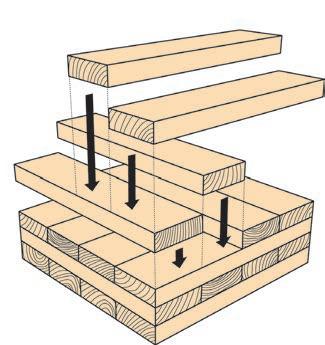
Moving forward requires learning from previous experience, of which data forms a large part. For this reason, BM TRADA and Stora Enso have conducted research to better understand the moisture dynamics in CLT. The two-part project looked at both wetting risk during construction and drying rates, information which can be used to determine moisture distribution behaviour.
The drying rates of five-layer, 100mmthick CLT panels were investigated; various configurations were tested, including covering the wet outer face of panels with foil to replicate panels covered with rigid foil-faced insulation boards and/or vapour control layers. This test set-up was intended to replicate typical UK construction build-ups for warm walls as well as flat and pitched roofs.
During testing of the covered panels, water in the wet outside face lamination was observed slowly passing through the thickness of the panels to the dry uncovered side, confirming the previously held assertion that panels could dry to the inside. However, with a starting moisture content of 35% in the wet outer lamination, it took almost 16 months for the moisture content to fall to 20%. This means drying could take years for higher moisture contents and/or thicker panels. On the flip side, uncovered panels that were able to dry directly from the wet face took approximately six weeks for a similar moisture content reduction.
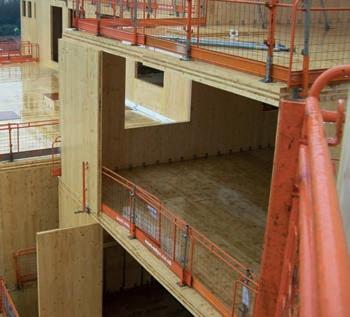
Figure 1: The drying mechanism of fivelayer, 100mm-thick CLT panels with (left) and without (right) foil coverings
Creating room to breathe
To achieve long-term durability of timber structures, a primary consideration is to provide a combination of drainage, ventilation and breathability. It is not normally an issue if timber gets wet, providing water can drain away quickly and the timber is subsequently allowed to dry. Slowing down or restricting drying though the use of high resistance insulation products and/or vapour control layers on the inner or outer faces of the panels can slow drying to an extent that the development of fungal decay may become a risk if panels are subjected to adverse conditions during construction or in service.
On the continent, CLT building systems are often paired with mineral wool or wood-fibre insulation products – these breathable insulation materials are typically beneficial to timber building systems as they allow more rapid drying of the CLT panels if they are exposed to wetting during construction or in service.
The use of breathable insulation products and systems, in conjunction with good overall design detailing and a moisture management plan for the construction phase, will have a significant positive impact on the long-term durability and robustness of CLT structures.
Planning ahead
CLT will no doubt play a key part in creating greener, low carbon buildings. To do so, an understanding of how to effectively protect CLT from moisture during construction is vital. Where moisture does pose issues, appropriate remedial action must be prioritised. This should also be taken into consideration at the onset of any timber construction project, particularly when allowing sufficient drying time to prevent fungal and structural decay.
FOR MORE ABOUT BM TRADA AND ITS RANGE OF TIMBER SERVICES, VISIT WWW.RDR.LINK/BAP043




product round-up
AIR BARRIER
A new self-build farmhouse in the beautiful Scottish countryside has been fitted with the Wraptite air-barrier from A. Proctor Group. The product provides essential protection in the form of waterproofing and weatherproofing and combines the critical properties of vapour permeability and airtightness in one self-adhering membrane.
GET MORE DETAILS AT: WWW.RDR.LINK/BAP044
NEW BUILD DESIGN SERVICE
A New Build Design Service from LG will assist new build developers when specifying heat pumps into new homes. It will provide full designs for plumbing and heating layouts along with equipment schedules that specify the heat pump required, radiator or underfloor manifold heating positions, pipework type and length and controls as well as determining the optimal location and performance simulation of the outdoor units.
GET MORE DETAILS AT: WWW.RDR.LINK/BAP045
HOUSEBUILDERS GUIDE
Leading timber staircase manufacturer, MultiTurn, has launched a free guide entitled ‘9 key challenges for housebuilders today… And ideas to help solve them’. Collecting data from the NHBC and HBF, the guide addresses the most pressing challenges facing the housebuilding industry as well as controlling costs and managing cashflow to survive.
DOWNLOAD THE GUIDE FOR FREE AT THE MULTI-TURN WEBSITE: WWW.RDR.LINK/BAP046
CARBON JARGON GUIDE
The NHBC Foundation has published a free guide to help explain and standardise the language used around carbon and energy in the housebuilding industry. From ‘absolute zero carbon’ to ‘zero carbon ready’, it details common energy terms, explaining what they mean and how they differ.
THE CARBON JARGON GUIDE IS AVAILABLE FROM: WWW.RDR.LINK/BAP047
NATURAL SLATE
CUPA PIZARRAS’ CUPA 12 natural slate has been specified for a new build project in Chichester. The non-carbonated slate is formed by tectonic compression, giving the product a smooth, matt surface, outstanding weather resistance, and a functional life expectancy of 100 years. CUPA 12 has been assessed and certified by BRE Global making it sustainable as well as aesthetically enhancing.
GET MORE DETAILS AT: WWW.RDR.LINK/BAP048 GUTTERING

An eco-friendly property in Suffolk is benefitting from Marley Alutec’s Evolve Deepflow and Aligator Giant guttering. Manufactured from corrosion resistant marine grade aluminium, a naturally occurring protective oxide that forms on the surface means that, if the layer becomes damaged, it will reform itself. As a result, it has a 50+ year functional life expectancy and requires minimal maintenance.
GET MORE DETAILS AT: WWW.RDR.LINK/BAP049
BREATHER MEMBRANE
Improvements in thermal comfort and airtightness are amongst the benefits of the ECHOFOIL EXO, a high-performance breather membrane. Manufacturer, Partel has developed the solution specifically for timber frame construction. The reflective foil membrane has one of the lowest emissivity values in the market of just ≤ 0.04 and a cavity R-Value of 0.78 m2K/W.
GET MORE DETAILS AT: WWW.RDR.LINK/BAP050
ROOF TILE VENT
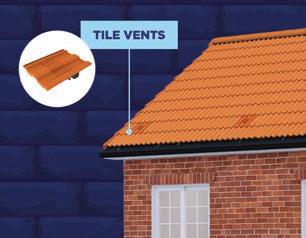
The InVentive Tile Vent from Timloc Building Products is now available from Rainclear Systems. The range of tile and slate vents are designed to suit profile, plain, small profile and non-profile roof tiles and slates as well as universal options and includes compatible accessories for connection to ventilation ducts or soil vent pipes.
GET MORE DETAILS AT: WWW.RDR.LINK/BAP051
BOXING CLEVER

Festool is turning the tables on precision sawing with its latest cordless solution
Picture the scene – you want to take your table saw on site but the job is up a couple of flights of stairs, and the tool is hardly what you’d describe as lightweight and compact. Some might even decide that they can make do with a jigsaw, but it’s the accuracy in the finish that will inevitably be the loser.
That’s hitherto been the reality for this class of machine, and most available in the market come with those inherent limitations. The challenge for the engineering team at Festool is to change all that by making precision genuinely portable, and the result is the cordless CSC SYS 50 table saw. Because all of the necessary elements are housed within Systainer boxes it fits seamlessly into your existing Festool ecosystem, is easily transported and integrated into bott van racking – but the advantages don’t stop there.
Indeed, to make carrying it even easier, the manufacturer has developed an underframe, which also functions as a hand trolley. Not only is it easy to secure the CSC SYS 50 table saw to that underframe but the trolley means you can take further Systainers to site with you. When in operation it offers an ergonomic working height of 90cm, helping protect your back, and providing an excellent overview of the workpiece. Fold the four legs in and the work surface is the perfect height for ground-level jobs, such as parquet flooring.
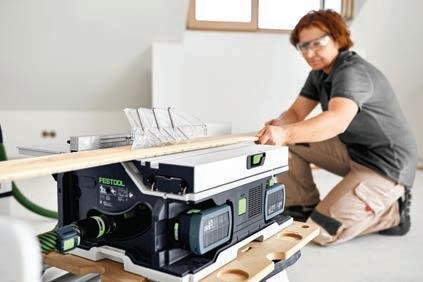
Multi-tasker
Not only that – even without the saw –the underframe equally functions as a sturdy and durable workbench. In addition, fold out the rest and you have a larger support surface for longer materials. So what you have is a hand trolley, workbench and underframe for your CSC SYS 50 table saw – a genuine three-in-one solution.
Once on site, to start setting up simply remove the Systainer cover. Inside you’ll find all the necessary accessories are neatly stored in the lid, so everything is always exactly where you need it, including angle fence, parallel side fence, dust bag, and saw blades. No power on site? No problem, because this is a battery powered machine that runs from two 18V batteries and, again, both of these can be stored in the Systainer box, along with a Duo rapid charger that will charge both batteries in as little as 30 minutes.
A digital display would usually be the preserve of a larger workshop-bound unit but, with the CSC SYS 50, Festool has brought the technology to the most compact of worksites. In second fix jobs, every millimetre matters and, in these applications, rotary wheels for adjusting the height and angle are never quite accurate enough. With the new Systainer Saw, however, precision can be achieved at the press of a button, with the height and angle set digitally.
Precise and accurate
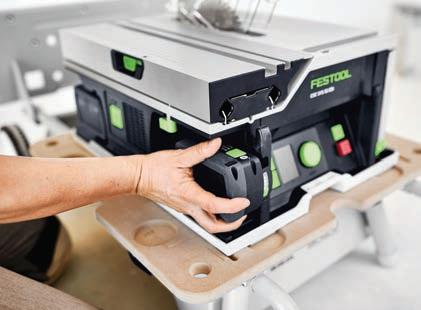
Set a height of 35.5mm, and an angle of 12.5mm, for example, and it will be accurate to a 10th of a millimetre. Simply press a button and the saw blade will automatically move to the chosen position. In addition, four saw blades positions can be stored, enabling cuts with 100 per cent repeat accuracy. Those settings can also be saved in the Festool Work app and then sent to the machine. The display can be changed from imperial to metric according to your preference, whilst different rotation speeds can also be established.
For completely autonomous working, Festool cordless dust extractors can be paired with the aforementioned battery packs, such as the CTC MINI Cordless, whilst the dust bag conveniently located in the Systainer can be used when only a few cuts need to be made.
For groove cuts or rebates the tool is equipped with a riving knife, which can be easily removed with the small key supplied. Following the now familiar theme, both key and riving knife have their own dedicated home in the Systainer cover.
If you want an indication of the machine’s accuracy then in our demonstration at Festool UK’s head office, we were treated to what the manufacturer describes as the bank note test. A £20 note was placed on the wood and then completely sawn through without violently depreciating your bank balance by cutting it in half – a task the machine achieved with aplomb.
When secured the rear part of the parallel side fence aligns automatically so that the fence is always aligned perpendicular to the front edge. Add to that ball-bearing mounted sliding table, which positively glides back and forth, and the attention to detail is dramatically demonstrated.

Versatile and powerful
Given its compactness you might expect a trade off in functionality but that’s not the case either. The table surface can be easily enlarged, giving a maximum cutting width of up to 280mm, and a cross cut width of 450mm, with mitre angle cuts of -70 to +70 degrees, or angle cuts with the saw blade of +10 to -10 degrees.
Again, you might assume a compromise on power between a mains and corded machine but, thanks to the combination of brushless EC-TEC motor and two 18V batteries, that’s not the case either. In fact, the CSC SYS 50 has just as much power as its plug in counterpart, with the manufacturer promising that cuts in over 100metres of chipboard can be achieved on a single charge, which could well be enough power for a week’s work. Moreover, the CSC SYS 50 cordless table saw is supplied with the same fine-tooth examples that come with the TS 60. Whether it’s plastic, laminate, aluminium soft or hard woods there is the right blade for every material.
As ever with Festool, register the tool online and you’ll benefit from the Festool warranty, with full repair free of charge including all wear parts. If that’s not enough, in the event of theft, the customer can have the tool completely replaced when subject to a £110 payment.
It’s the focus on design that sets a company like Festool apart but it isn’t merely about aesthetics, because precision and practicality are the guiding principles. The Festool CSC SYS Table Saw – the ‘Systainer Saw’ –exemplifies that approach and is the perfect partner to carpenters, joiners and kitchen fitters who carry out any kind of high quality and accurate interior work on site.



